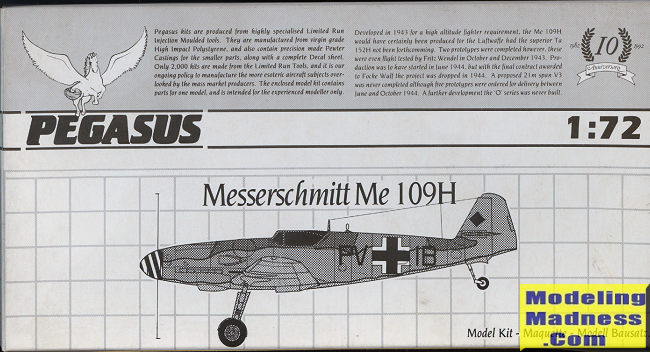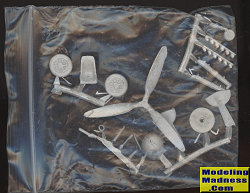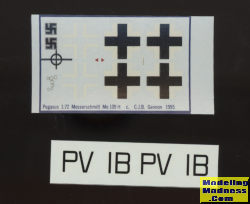
Pegasus 1/72 Me-109H
| KIT #: | 2015 |
| PRICE: | $ |
| DECALS: | One option |
| REVIEWER: | Scott Van Aken |
| NOTES: | 1995 release. Short run with metal parts |

| HISTORY |
The Bf 109H was intended to be a high-altitude fighter, developed from the F-series. The wingspan was increased through the addition of new, constant-chord inner wing panels to 11.92 m (39.11 ft), and the widened stabilizer again received a supporting strut leading from the fuselage, like the B through E models. Maximum speed was 750 km/h (470 mph) at 10,100 m (33,140 ft). A small number of Bf 109 H-1s were built, flying several sorties over Britain and France. Bf 109H-2 and H-5 developments were also planned, but the entire H-series was scrapped because of wing flutter problems.
A record exists of one particular Bf 109H-1, Werknummer 110073, was recorded as having been converted to a photo-recon aircraft by a Luftwaffe long-range reconnaissance group, Fernaufklärungsgruppe 123, in May 1944, and flown on dates immediately following the Invasion of Normandy with one mission meant to scan the entire French coastline from Cherbourg to Ouistreham, from an altitude of some 15 km (49,200 ft), which proved to be just beyond the achievable ceiling of the selected aircraft.
| THE KIT |
 Pegasus
was well known for producing low pressure mold short run kits. Their kits have
fairly thick plastic and use cast metal for many of the thinner detail parts.
This one is no exception using metal for a variety of the pieces as you can see
in the image provided. The cockpit is fairly basic but no worries as you won't
see much through the thick clear plastic parts.
Pegasus
was well known for producing low pressure mold short run kits. Their kits have
fairly thick plastic and use cast metal for many of the thinner detail parts.
This one is no exception using metal for a variety of the pieces as you can see
in the image provided. The cockpit is fairly basic but no worries as you won't
see much through the thick clear plastic parts.
 The wing
comprises six pieces with three upper and three lower sections. The tailplanes
are a single part and fit atop the rear fuselage with the fit then fitting on
top of it. Landing gear are all cast metal as are the parts for the propeller.
As with all of Pegasus' kits, the modeler
The wing
comprises six pieces with three upper and three lower sections. The tailplanes
are a single part and fit atop the rear fuselage with the fit then fitting on
top of it. Landing gear are all cast metal as are the parts for the propeller.
As with all of Pegasus' kits, the modeler
 will need to
do a lot of test fitting and trimming. This is a fairly basic kit, but not one
for the new modeler.
will need to
do a lot of test fitting and trimming. This is a fairly basic kit, but not one
for the new modeler.
Instructions are simply an exploded view. Markings are provided for one plane in RLM 74/75/76 and the decal placement guide is shown on the back of the kit box. The small decal sheets are nicely printed and while a bit thick, should still be viable. Markings are for a single aircraft. I have to assume that the radio call sign provided is one assigned to the 109H, as no photos of any of the planes have surfaced over the years.
| CONCLUSIONS |
This one could almost be considered a candidate for the 'Luft 46' crowd, but there is enough evidence for it having existed to return it to the realm of reality. The subject has not left the short run realm with RS Models having produced several kits of this aircraft. While this may not be the most modern kit around, those with the skills can easily turn it into a nice one for the shelf.
March 2023
Copyright ModelingMadness.com. All rights reserved. No reproduction in part or in whole without express permission.
If you would like your product reviewed fairly and fairly quickly, please contact the editor or see other details in the Note to Contributors.